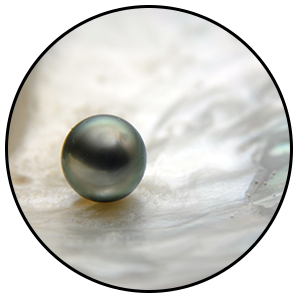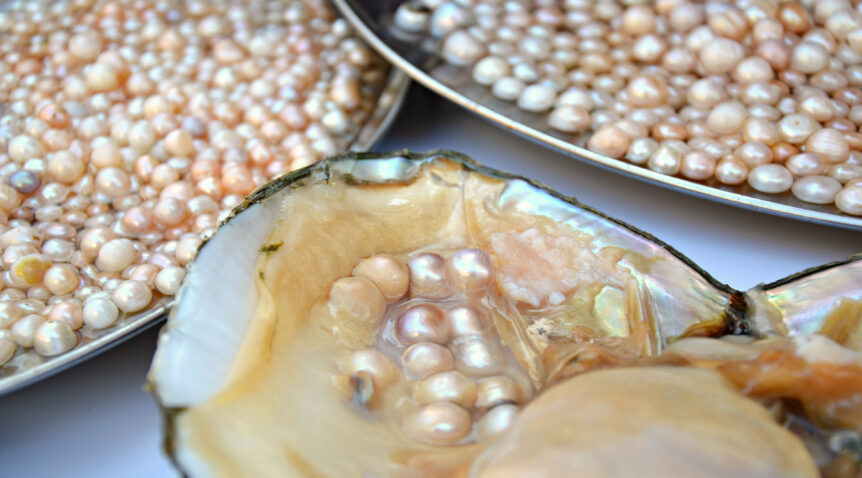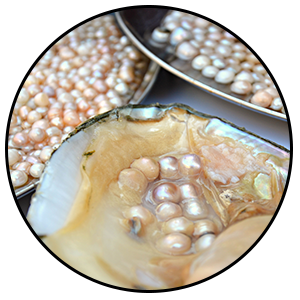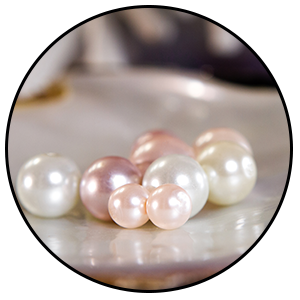In the jewelry market today, with the development of science and technology in culture. People have been able to create many types of Pearls with full of different colors. Basically, cultured pearls are divided into 2 groups: Cultured in freshwater and sea environments. Below are some methods to distinguish and explain the meaning of both types of pearls.
1. Pearl color
Sea pearls have a natural color. Due to the characteristics of some mussels in different seas, it can produce pearls with unique characteristics such as French Tahiti black pearl, South Sea golden pearl of the South Pacific, or white, cream yellow, light pink of Akoya pearls.
Original freshwater pearls have light colors, soft nacre cells, color is not fresh. Freshwater pearls are usually white, cream, wine color Champ, light purple, light pink, light orange.
Freshwater pearl.
Tahiti pearls

2. The shiny of pearl
With a long time of culture in the ocean environment with countless types of microorganisms and a diverse and rich source of minerals, sea pearls absorb many nutrients and essences from the seabed. Therefore, seawater pearls have a glossy pearl layer, which reflects bright light.
Meanwhile, the specific food source and characteristics of freshwater mussels cannot create a beautiful pearl like sea pearls. We can distinguish it easily when we seen with the normal eye. If placed two types of pearls next to each other, the freshwater pearl will be less shiny.
3. the hardness of pearls
Sea pearls have a high nacre hardness, from 3.8 to 4.5 Moha (the Mohs is a hardness unit for gems).
The hardness of freshwater pearl is only 1.8 Moha. They are easily affected by the external environment such as nacre or corrosion. Therefore, freshwater pearls are much less durable than sea pearls. Low hardness is also the reason why the surface structure of pearls is not as shiny as sea pearls.
4. The nacre thickness of pearls
Sea pearls are covered with a layer of nacre, about 0.35mm to 6mm thick:
Japanese Akoya pearls: from 0.35 to 0.7mm
Tahiti pearls from: 1 to 3mm (the law of Tahiti requires a minimum of 0.8mm)
South Sea pearl: from 1.5 to 6mm
Freshwater pearls are almost entirely nacre. This difference is due to the fact that the embryo without a hard nucleus to inserted and it is much smaller than that of a sea cultured pearl. Because it is too thick on a small implant and has low hardness, the nacre of freshwater pearls is often unstable, prone to wear, peeling, splitting.
5. Shape of pearl
Because of the pre-shaped nucleus, the seawater pearls are usually round and regular.
The shape of freshwater pearls is not round like sea pearls and most are oval, teardrop, button-shaped, oval, hemisphere …
6. The size of pearl
The average culture period of sea pearls is 2 years. Especially South Sea and Tahiti pearls have transplant time up to 4-5 years, while Akoya pearls take about 12-18 months. Because of the long culture time, the size of pearl can be up to 23mm or larger.
The cultivation period for freshwater pearls is much shorter, only about 6-12 months. Therefore, the size of freshwater pearl is smaller, ranging from 3mm – 12mm. Short farming time also makes the pearl quality low.
7. The value of pearl
Difficult culture conditions, scarce pearls, low pearl formation rate, long culturing time and most importantly, sea pearls are not chemically treated, retain their natural color, so the value of Sea pearls are very high, listed as the most valuable jewelry in the world.
Because the shiny, the hardness, durability, color is much less than sea pearl and can be transplanted with many nuclei at the same culture times , the culture time is short, so water pearls Sweet is more affordable than sea pearls.
Jewelry made from sea pearls.
Freshwater pearl.
Hopefully the above information is really useful, so that you can be more proactive in classifying Pearl Jewelry.
# Articles of general evaluation nature, in practice the value of sea or freshwater pearls must be tested through most of the steps for selection and valuation.





